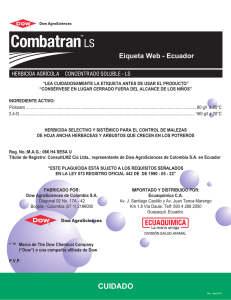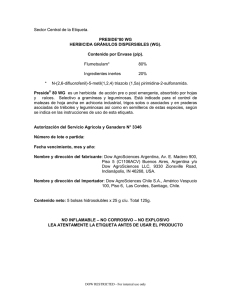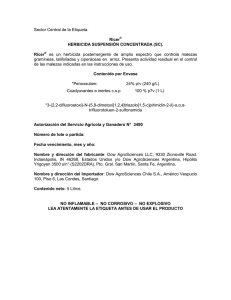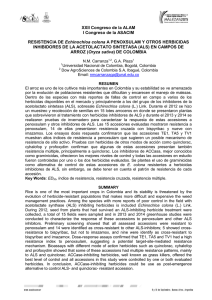XXII Congreso de la ALAM I Congreso de la ASACIM UNA
Anuncio
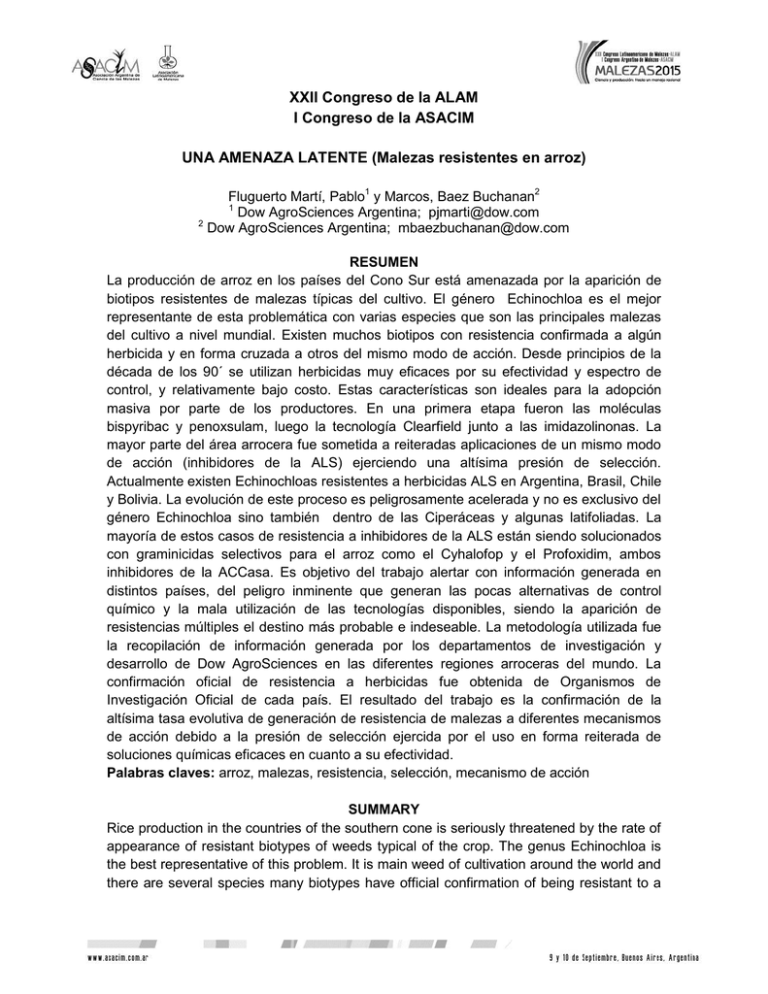
XXII Congreso de la ALAM I Congreso de la ASACIM UNA AMENAZA LATENTE (Malezas resistentes en arroz) Fluguerto Martí, Pablo1 y Marcos, Baez Buchanan2 1 Dow AgroSciences Argentina; pjmarti@dow.com 2 Dow AgroSciences Argentina; mbaezbuchanan@dow.com RESUMEN La producción de arroz en los países del Cono Sur está amenazada por la aparición de biotipos resistentes de malezas típicas del cultivo. El género Echinochloa es el mejor representante de esta problemática con varias especies que son las principales malezas del cultivo a nivel mundial. Existen muchos biotipos con resistencia confirmada a algún herbicida y en forma cruzada a otros del mismo modo de acción. Desde principios de la década de los 90´ se utilizan herbicidas muy eficaces por su efectividad y espectro de control, y relativamente bajo costo. Estas características son ideales para la adopción masiva por parte de los productores. En una primera etapa fueron las moléculas bispyribac y penoxsulam, luego la tecnología Clearfield junto a las imidazolinonas. La mayor parte del área arrocera fue sometida a reiteradas aplicaciones de un mismo modo de acción (inhibidores de la ALS) ejerciendo una altísima presión de selección. Actualmente existen Echinochloas resistentes a herbicidas ALS en Argentina, Brasil, Chile y Bolivia. La evolución de este proceso es peligrosamente acelerada y no es exclusivo del género Echinochloa sino también dentro de las Ciperáceas y algunas latifoliadas. La mayoría de estos casos de resistencia a inhibidores de la ALS están siendo solucionados con graminicidas selectivos para el arroz como el Cyhalofop y el Profoxidim, ambos inhibidores de la ACCasa. Es objetivo del trabajo alertar con información generada en distintos países, del peligro inminente que generan las pocas alternativas de control químico y la mala utilización de las tecnologías disponibles, siendo la aparición de resistencias múltiples el destino más probable e indeseable. La metodología utilizada fue la recopilación de información generada por los departamentos de investigación y desarrollo de Dow AgroSciences en las diferentes regiones arroceras del mundo. La confirmación oficial de resistencia a herbicidas fue obtenida de Organismos de Investigación Oficial de cada país. El resultado del trabajo es la confirmación de la altísima tasa evolutiva de generación de resistencia de malezas a diferentes mecanismos de acción debido a la presión de selección ejercida por el uso en forma reiterada de soluciones químicas eficaces en cuanto a su efectividad. Palabras claves: arroz, malezas, resistencia, selección, mecanismo de acción SUMMARY Rice production in the countries of the southern cone is seriously threatened by the rate of appearance of resistant biotypes of weeds typical of the crop. The genus Echinochloa is the best representative of this problem. It is main weed of cultivation around the world and there are several species many biotypes have official confirmation of being resistant to a herbicide and cross-shaped to others of the same mode of action. Since the beginning of the decade of the 90´ has been used in these countries very effective herbicides in terms of their effectiveness in the control of broad-spectrum and relatively low cost These are the ideal characteristics for the massive adoption by producers. In the first stage were bispyribac and penoxsulam molecules to then make their appearance Clearfield technology along with its family of the imidazolinone herbicides. Most of the rice area was subjected to repeated applications of a same mode of action (ALS inhibitors) exercising a high selection pressure currently there are confirmed cases of Echinochloas resistant to herbicides ALS in Argentina, Brazil, Chile and Bolivia. The evolution of this process is dangerously accelerated and is not exclusive of the genus Echinochloa but also problematic cases are emerging inside the Ciperáceas and some broadleaf weeds. The majority of these cases of resistance to ALS inhibitor herbicides are being solved with the use of selective rice grasskillers such as the Cyhalofop and the Profoxidim, both ACCasa inhibitors. Aim of this work is alert with information generated in different countries of the impending danger that brings with it the few alternatives in terms of chemical control and the improper use of the technologies available, being the emergence of multiple resistance the more probable and undesirable destination
